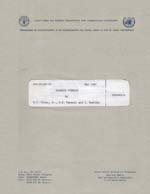
Seaweed Farming Indonesia
| Work Plan Implementation | SCS/80/WP/91 |
| (Working Paper) |
 |
South China Sea Fisheries Development and Coordinating Programme Seaweed Farming Indonesia |
by
G.C. Trono, Jr., H.R. Rabanal and I. Santika
NOTICE OF COPYRIGHT
The copyright in this publication is vested in the Food and Agriculture Organization of the United Nations. This publication may not be reproduced, in whole or in part, by any method or process, without written permission from the copyright holder. Applications for such permission with a statement of the purpose and extent of the reproduction desired, should be made through and addressed to the Programme Leader, South China Sea Fisheries Development and Coordinating Programme, P. O. Box 1184, M.C.C., Makati, Metro Manila, Philippines.
FAO/UNDP South China Sea Fisheries Development and Coordinating Programme
Manila, Philippines
May 1980
Hyperlinks to non-FAO Internet sites do not imply any official endorsement of or responsibility for the opinions, ideas, data or products presented at these locations, or guarantee the validity of the information provided. The sole purpose of links to non-FAO sites is to indicate further information available on related topics.
This electronic document has been scanned using optical character recognition (OCR) software. FAO declines all responsibility for any discrepancies that may exist between the present document and its original printed version.
2.2 Local contacts and interviews
2.3.1 Terura, Genoa, Bali province
2.3.2 Serengan Island Reef, Bali province
2.3.3 Channel between Lembangan and Ceningan Islands, Bali province
2.3.4 Pegametan Baai, Bali province
2.3.5 Labuan Hadji, Eastern Lombok, West Nusa Tenggara province
2.3.6 Reefs between Maringi, Kambing (Bembe) Islands, West Nusa Tenggara province
2.3.7 Pulau Dapi (Santong Bay), Sumbawa Island, West Nusa Tenggara province
2.3.8 Oetefu Kecil, Pulau Semau, East Nusa Tenggara province
2.3.9 Tablolong Reef, East Nusa Tenggara province
3.1 Assessment of suitability of site
3.1.3 Accessibility of the area
3.1.4 Management of the pilot farms
3.2 Recommended sites for development
3.2.2 Gracilaria production site
4. PROJECT SUMMARY OF PROPOSAL FOR TECHNICAL ASSISTANCE
Table 1 Evaluation of potential sites for seaweed farming
Table 2 Production, exports and imports of seaweeds in Indonesia
Figure 1 Map of Indonesia showing the general locations of sites visited
Figure 2 Map showing areas surveyed in Denpasar, Bali province
Figure 4 Map showing areas surveyed at Pegametan Baai, Bali province
Figure 5 Map showing areas surveyed in Lombok Island, West Nusa Tenggara province
Figure 6 Map showing sites surveyed in Lombok Island, West Nusa Tenggara province
Figure 8 Map showing areas surveyed in Pulau Semau and Kupang, East Nusa Tenggara province
ANNEX A Itinerary of the consultant
ANNEX B List of officials contacted/interviewed during the trip
ANNEX D Preliminary list of equipment/supplies needed
REPORT OF TECHNICAL ASSISTANCE ON SEAWEED FARMING IN INDONESIA1
by
G.C. Trono, Jr.2, H.R. Rabanal3 and I. Santika4
Upon the request of the Government of Indonesia, a short-term technical assistance on seaweed farming was rendered. The authors gathered available background information and field work led by the senior author was conducted in four selected provinces in the country in April 1980. Nine sites were surveyed, three of which were identified as suitable sites for pilot demonstration of seaweed farming. A programme of development of these farms and the facilities and training needs required are described. A draft proposal for technical assistance project in this type of seafarming is appended.
1 This consultancy was made possible from funds made available from project INS/72/003.